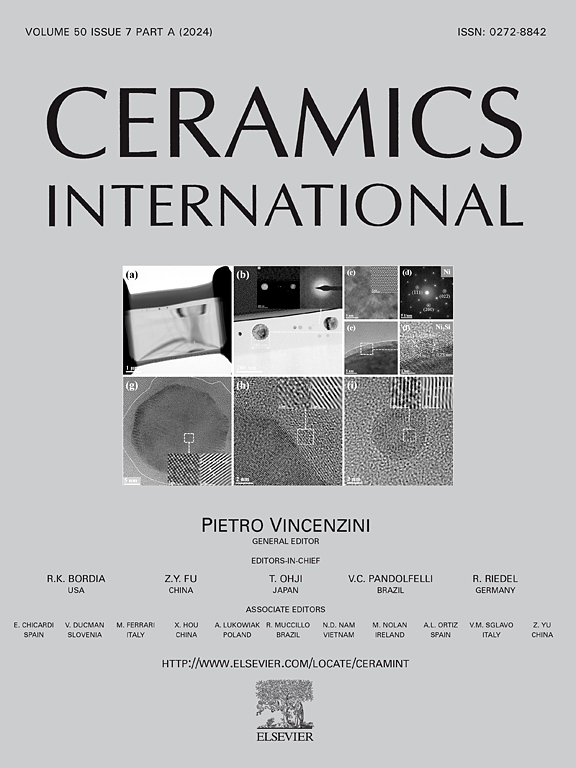Enhancing corrosion resistance of mild steel with a hybrid surface coating: Film-forming zinc titanate/oleic acid composites
IF 5.1
2区 材料科学
Q1 MATERIALS SCIENCE, CERAMICS
引用次数: 0
Abstract
Coatings made from ceramic materials have shown remarkable effectiveness in preventing surface corrosion on mild steel (MS) surfaces. The coating's stability was enhanced by incorporating various elements into the matrix. This study incorporated an organic fatty acid, specifically oleic acid (OA)into the zinc titanate (ZT). It forms a ZT/OA hybrid film-like coating on the MS surface. The synthesized ZT/OA nanomaterials were thoroughly characterized using PXRD, FT-IR, and SEM. The cubic spinel structure of ZnTiO3 and its spherical morphology were revealed from these techniques. The ZT/OA composites were applied to the surface of mild steel, and a film was formed under ambient conditions at a temperature of 150 °C. An investigation was conducted on the electrochemical corrosion behaviors of ZT/OA composites in three electrode systems using both saline and acidic mediums. This study involved measuring the impedance and Tafel polarization corrosion data. The results indicate that the ZT40 (60 wt% oleic acid-doped) sample Showed a significantly higher resistance of 37638 Ω cm2, coupled with an impressive inhibition efficiency of 99.3 % under saline conditions. Furthermore, under acidic conditions, the ZT40 sample exhibited excellent performance, as evidenced by the results of 691 Ω cm2 and 97 % inhibition efficiency.
求助全文
约1分钟内获得全文
求助全文
来源期刊

Ceramics International
工程技术-材料科学:硅酸盐
CiteScore
9.40
自引率
15.40%
发文量
4558
审稿时长
25 days
期刊介绍:
Ceramics International covers the science of advanced ceramic materials. The journal encourages contributions that demonstrate how an understanding of the basic chemical and physical phenomena may direct materials design and stimulate ideas for new or improved processing techniques, in order to obtain materials with desired structural features and properties.
Ceramics International covers oxide and non-oxide ceramics, functional glasses, glass ceramics, amorphous inorganic non-metallic materials (and their combinations with metal and organic materials), in the form of particulates, dense or porous bodies, thin/thick films and laminated, graded and composite structures. Process related topics such as ceramic-ceramic joints or joining ceramics with dissimilar materials, as well as surface finishing and conditioning are also covered. Besides traditional processing techniques, manufacturing routes of interest include innovative procedures benefiting from externally applied stresses, electromagnetic fields and energetic beams, as well as top-down and self-assembly nanotechnology approaches. In addition, the journal welcomes submissions on bio-inspired and bio-enabled materials designs, experimentally validated multi scale modelling and simulation for materials design, and the use of the most advanced chemical and physical characterization techniques of structure, properties and behaviour.
Technologically relevant low-dimensional systems are a particular focus of Ceramics International. These include 0, 1 and 2-D nanomaterials (also covering CNTs, graphene and related materials, and diamond-like carbons), their nanocomposites, as well as nano-hybrids and hierarchical multifunctional nanostructures that might integrate molecular, biological and electronic components.
 求助内容:
求助内容: 应助结果提醒方式:
应助结果提醒方式:


